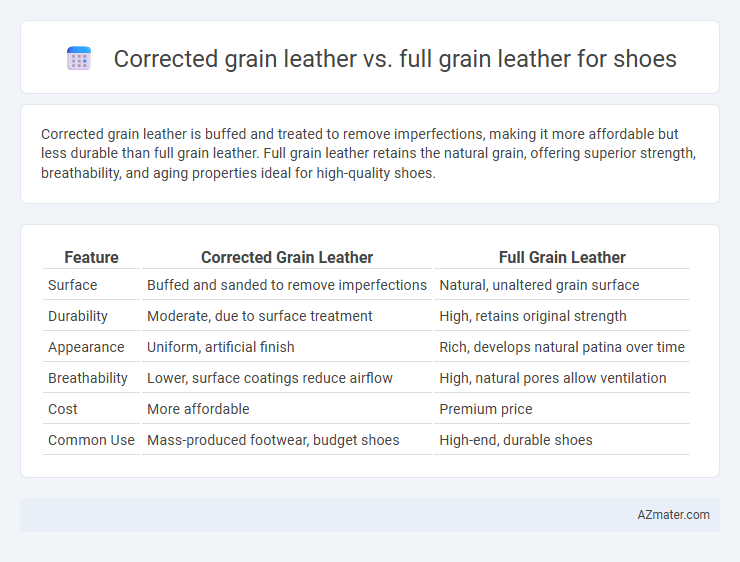Corrected grain leather is buffed and treated to remove imperfections, making it more affordable but less durable than full grain leather. Full grain leather retains the natural grain, offering superior strength, breathability, and aging properties ideal for high-quality shoes.
Table of Comparison
| Feature | Corrected Grain Leather | Full Grain Leather |
|---|---|---|
| Surface | Buffed and sanded to remove imperfections | Natural, unaltered grain surface |
| Durability | Moderate, due to surface treatment | High, retains original strength |
| Appearance | Uniform, artificial finish | Rich, develops natural patina over time |
| Breathability | Lower, surface coatings reduce airflow | High, natural pores allow ventilation |
| Cost | More affordable | Premium price |
| Common Use | Mass-produced footwear, budget shoes | High-end, durable shoes |
Introduction to Leather Types in Shoe Manufacturing
Corrected grain leather undergoes surface sanding and stamping to remove imperfections, resulting in a uniform appearance suitable for stylish yet affordable shoes. Full grain leather retains the natural grain and strength of the hide, offering superior durability, breathability, and a premium look favored in high-end footwear. Shoe manufacturing often balances cost and quality by selecting corrected grain for mid-range products and full grain leather for luxury collections.
What is Full Grain Leather?
Full grain leather is the highest quality leather made from the top layer of the animal hide, retaining its natural grain and imperfections for durability and breathability. Corrected grain leather is sanded and embossed to remove imperfections, resulting in a uniform appearance but reduced breathability and natural texture. Shoes made from full grain leather offer superior strength, aging beautifully with a unique patina, unlike corrected grain leather which sacrifices authenticity for aesthetics.
What is Corrected Grain Leather?
Corrected grain leather is a type of leather that has been sanded and buffed to remove imperfections, then stamped with an artificial grain pattern for a uniform look, commonly used in shoe manufacturing for enhanced durability and aesthetic appeal. Unlike full grain leather, which retains the natural surface and develops a unique patina over time, corrected grain leather offers a consistent appearance and increased resistance to stains and scratches. This makes corrected grain leather a cost-effective alternative ideal for shoes needing a polished, flawless finish without the premium price of full grain leather.
Key Differences between Corrected Grain and Full Grain Leather
Corrected grain leather undergoes sanding and buffing to remove surface imperfections, followed by an artificial grain embossing for uniform appearance, while full grain leather retains its natural surface and develops a unique patina over time. Full grain leather offers superior breathability, durability, and strength due to the intact grain layer, whereas corrected grain leather sacrifices some strength and breathability for a smoother, more consistent look. Shoes made from full grain leather provide better aging characteristics and longevity compared to those made from corrected grain leather.
Durability: Full Grain vs Corrected Grain Leather Shoes
Full grain leather shoes offer superior durability due to the retention of the entire grain layer, which provides enhanced strength and resistance to wear. Corrected grain leather, having been sanded and refinished to remove imperfections, is less durable because the natural grain is compromised. For long-lasting footwear, full grain leather maintains structural integrity and ages better than corrected grain alternatives.
Appearance and Aesthetic Qualities
Full grain leather maintains the natural texture and markings of the hide, offering a rich, authentic appearance that develops a unique patina over time, enhancing the shoe's aesthetic appeal. Corrected grain leather undergoes sanding and coating processes to hide imperfections, resulting in a more uniform but less natural look with a synthetic finish. Shoes crafted from full grain leather typically present a higher-end, luxurious appearance, while corrected grain leather delivers consistent color and surface but lacks the depth and character associated with premium footwear.
Breathability and Comfort Comparison
Full grain leather offers superior breathability and comfort compared to corrected grain leather due to its natural, unaltered surface that retains the material's original porous structure. Corrected grain leather undergoes sanding and coating processes that reduce airflow and flexibility, often resulting in less comfort and limited moisture evaporation. Shoes made from full grain leather typically provide enhanced temperature regulation and a more comfortable fit for prolonged wear.
Care and Maintenance Requirements
Corrected grain leather requires more frequent cleaning and conditioning due to its treated surface, which can easily show wear and cracking if neglected. Full grain leather demands less intensive maintenance but benefits from regular brushing, conditioning, and proper drying to preserve its natural fibers and enhance durability. Proper care techniques for both types extend the lifespan of shoes, with full grain leather offering superior breathability and resistance to moisture compared to corrected grain.
Cost and Value Differences
Corrected grain leather is more affordable than full grain leather due to its surface sanding and refinishing processes that mask natural imperfections, making it cost-effective for budget-conscious shoe buyers. Full grain leather retains the entire natural surface, offering superior durability, breathability, and aging qualities that increase its long-term value and justify a higher price point. Shoes crafted from full grain leather often provide enhanced comfort and longevity, representing a better return on investment despite their initial cost.
Which Leather Type is Best for Shoes?
Full grain leather, derived from the top layer of the hide, boasts superior durability, natural breathability, and develops a rich patina over time, making it the best leather type for high-quality shoes. Corrected grain leather is sanded and buffed to remove imperfections, then often embossed to mimic natural grain, which reduces durability and breathability but offers a more uniform appearance at a lower cost. For shoes designed to last and age beautifully, full grain leather outperforms corrected grain leather in strength, comfort, and overall value.

Infographic: Corrected grain leather vs Full grain leather for Shoe
 azmater.com
azmater.com